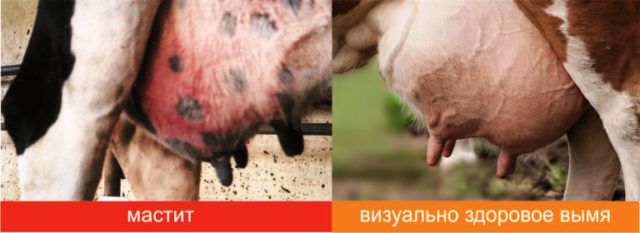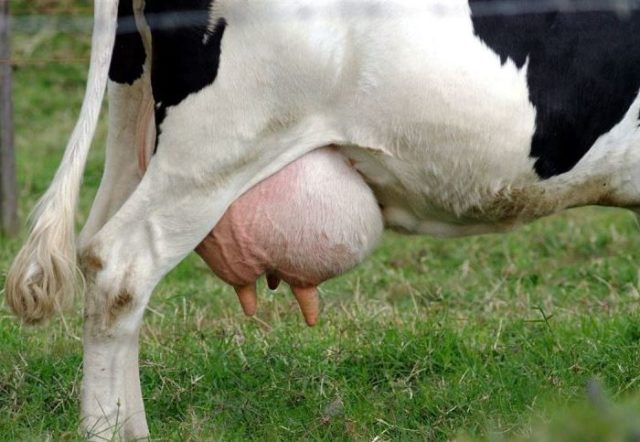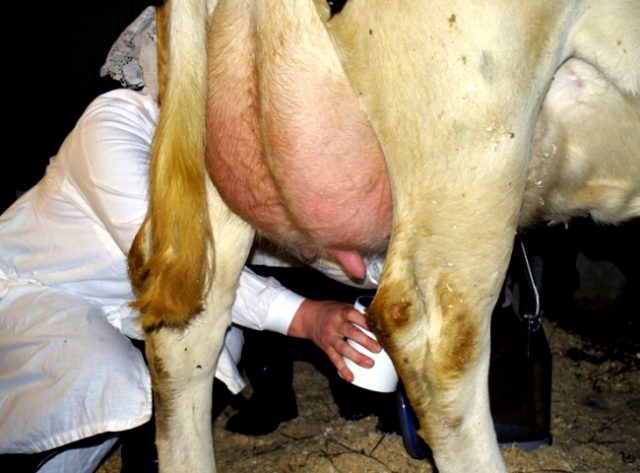Content
- 1 What is mastitis in a cow?
- 2 What does mastitis look like in a cow?
- 3 What causes mastitis in cows?
- 4 Classification of mastitis in cows
- 5 How to check for mastitis in a cow
- 6 How to treat mastitis in cows
- 7 Preparations for mastitis in cows
- 8 Udder massage for mastitis
- 9 Is it possible to drink milk if a cow has mastitis?
- 10 How to milk a cow after mastitis
- 11 Prevention of mastitis in cows
- 12 Conclusion
Every farmer should know the symptoms of mastitis and medications for the treatment of breast pathology. At the initial stage, it is important to distinguish this disease from a number of other similar diseases. Before starting treatment, you should consult a veterinarian and establish an accurate diagnosis.
What is mastitis in a cow?
Mastitis is an inflammatory disease of the cow's mammary gland. As a rule, the causative agents are some types of staphylococci or streptococci. Other types of infections are quite rare. This disease is one of the most unprofitable in cattle breeding, since during the disease the milk yield drops significantly. During treatment, consuming dairy products is prohibited due to the presence of antibiotics in them. The recovery period takes some time.
The causes of the disease are varied, but responsibility for such pathological processes lies with the cattle breeder.
Cows with certain anatomical features of the udder are predisposed to the disease. It is believed that individuals with an elongated gland and funnel-shaped nipples are most susceptible to this disease. It has also been noted that certain breeds of cattle often suffer from mastitis - Simmental, Red Steppe. To some extent, the development of the disease can be influenced by immunity, time of year, age, and the physiological state of the animal. Mastitis often occurs in cows on large farms where milking occurs using milking machines. Domestic animals practically do not suffer from this pathology.
What does mastitis look like in a cow?
Symptoms of mastitis and its manifestations depend on the form of the disease. Particularly attentive, experienced milkmaids and cattle breeders can detect the disease at an early stage. The onset of the disease is indicated by the following symptoms:
- redness of the nipple;
- there are small admixtures of curd flakes in the milk;
- the volume of milk production is significantly reduced.
In some forms of mastitis, the udder changes color and spots appear on the skin. Over time, other signs of the disease appear:
- the udder or individual lobes swell, the temperature rises;
- there is pain on palpation, the presence of compactions;
- lymph nodes become enlarged;
- A viscous white secretion appears from the gland.
The general condition of the cow also changes. She loses her appetite, there is some lethargy, her breathing becomes rapid, and her pulse increases.
What causes mastitis in cows?
The disease appears in cows during lactation and can often occur in a latent form.If mastitis is detected in a cow, it must be isolated from the rest of the herd. Pathogens enter the animal’s body in the following way:
- for inflammation during endometriosis;
- through the milk ducts during milking;
- through cracks and wounds on the skin of the udder - they are the entrance gates for infection.
Factors that can provoke the development of mastitis in a cow are postpartum inflammatory processes, damage to the udder from a blow, poor milk yield, unsanitary conditions in the barn, and a poor diet.
Congenital predisposition also plays an important role in the development of mastitis.
But the main cause of mastitis in a cow is the animal’s weak immune system, in which the body cannot resist infection and provoking factors.
Classification of mastitis in cows
Symptoms of mastitis in cows can vary significantly with different forms of the disease. The following types of disease are distinguished:
- serous;
- catarrhal;
- fibrous;
- purulent;
- hemorrhagic;
- colimastitis;
- subclinical.
Serous mastitis can affect cows after calving. This form is acute. The udder turns red, swells, and becomes hard. Simultaneously with these manifestations, the volume of milk and its fat content decrease. Serous mastitis very quickly becomes chronic, so you will need urgent help from a veterinarian.
The catarrhal form of mastitis mainly affects first-calf heifers. The first symptoms of the disease make themselves felt immediately after calving. A cow develops mastitis in one lobe or quarter. After slight compaction, nodules are detected a week later.This is a blockage in the milk ducts. With catarrhal disease, the cow behaves relatively calmly, but the quality of the milk deteriorates every day: its fat content decreases, flakes and clots appear.
The fibrous form of mastitis is considered especially dangerous among all others. The onset of the disease is characterized by a sharp rise in body temperature, the cow begins to limp and becomes restless upon palpation. Milk yield decreases, and in the affected part of the udder, lactation stops altogether.
With the purulent development of mastitis, there are clots of casein and pus in the milk. The cow is depressed, there is no appetite, the animal prefers to lie down. Gangrene develops inside the udder. Purulent mastitis is divided into purulent-catarrhal, phlegmon, abscess.
Clinical signs of the hemorrhagic form of mastitis in a cow are blood in the milk and an increase in the animal’s body temperature to 41 °C. The general condition of the individual is depressed.
With the development of colimastitis, lactation stops completely, even if only one lobe of the mammary gland is affected. Body temperature rises to 42°C, signs of exhaustion and dehydration appear. This form of mastitis is extremely difficult to treat.
With the development of subclinical mastitis, there are no obvious symptoms, but the infection spreads rapidly. In this case, the disease can only be detected by monitoring the milk flora. If you miss the onset of the disease, it will develop into a serous form, and then into a chronic one.
The chronic form of mastitis manifests itself if the acute stage went unnoticed, and the animal’s body coped with it on its own. The diagnosis can be made by analyzing milk, using the settling method or using a special test.The chronic form should be treated despite the absence of symptoms, otherwise mastitis will periodically worsen.
How to check for mastitis in a cow
In order not to miss the onset of mastitis, it is necessary to have milk tested once a month throughout the entire lactation period. Sometimes a similar test for mastitis in cows is carried out at home. To do this, use a 5% solution of dimastin and special milk-control plates.
1 ml of milk is expressed into each cell from the milking that corresponds to the share of the cow's udder. Add 1 ml of dimastin to each sample, mix everything and observe for about 15 minutes.
If the liquid remains homogeneous, then the reaction to mastitis is negative. With jelly-like traces - doubtful. A clot indicates a positive reaction. Color also matters. An orange tint is normal, red indicates the presence of pathology.
As an additional examination, you can use the settling method:
- First, you should milk 10 ml of milk from each nipple;
- put it in the refrigerator for 17 hours at a temperature of 10 °C;
- then examine the color, sediment, and width of the fatty layer.
A cow with mastitis has watery milk with a sediment of more than 1 mm.
Bromthymol testing is widely used in veterinary medicine. A solution of 0.5 substances is mixed with distilled water. Add a couple of drops of the mixture to 1 ml of milk and observe the color change. The presence or absence of the disease is determined by its shade.
Each sample has some error, so several tests should be carried out using different methods and preparations.
How to treat mastitis in cows
The treatment regimen for mastitis in cows depends on the severity and form of the disease. In any case, antibiotic therapy is most important. The animal should be isolated in a clean room, ensure complete rest, reduce the amount of water and succulent feed to reduce milk production. The following therapeutic measures will also be useful:
- rubbing in antibacterial ointments;
- applying bandages, compresses with medicinal products;
- udder massage before and after milking;
- milking 4 times a day only by hand;
- washing the milk ducts with antibiotic solutions;
- washing the mammary gland with warm water 5-6 times a day.
Mastitis in early cows can be treated with antibiotics. This is one of the most effective methods of getting rid of infection. Therapy is carried out comprehensively, with the use of vitamins and restorative drugs.
Treatment of chronic mastitis in cows
Getting rid of chronic mastitis is quite difficult. Therefore, treatment must be comprehensive. They use drugs containing hormones, antibiotics, and antibacterial substances. Vaccines against mastitis in cows can be used. Some of these products are made with antibiotics and can act against bacteria.
Homeopathic medicines in the form of gels and vaccines are widely used. They combine well with traditional methods of treatment and have no side effects.
Mastitis in cows is sometimes successfully treated without the use of antibiotics. Often a special composition is used for this: 40 ml of a 2% novocaine solution, 60 ml of 40% glucose, 60 ml of calcium borogluconate are mixed and heated to 38 °C. The solution must be injected into the peritoneum into the area of the hungry fossa 3 times, every 48 hours.
A good effect is achieved when treating mastitis in cows with antibiotics, especially during the dry period.
Treatment of acute mastitis in a cow
Mastitis negatively affects the general condition of the cow's body. Antibiotics will not be enough, so general strengthening drugs are prescribed to restore the immune system. For acute forms of the disease, use:
- streptocide solution;
- glucose;
- sodium chloride solution;
- novocaine solution;
- ichthyol solution inside the udder.
When abscesses or suppurations appear, they must be opened. The procedure must be performed by a veterinarian. After opening, the wounds will require special care.
In particularly difficult cases - abscess, phlegmon, gangrene, the following is used:
- saline solution with novocaine;
- methenamine with calcium chloride;
- a solution of potassium permanganate is injected into the sore nipple for gangrene.
To maintain the body of the cow, medications containing caffeine are prescribed.
Preparations for mastitis in cows
Cows with mammary gland disease should be treated by a qualified specialist. As a rule, regardless of the form of the pathology, therapy will be complex, consisting of compresses, physiotherapeutic procedures, taking antibacterial drugs, as well as folk remedies.
Treatment with medications is carried out several times a day at certain hours. For this, sterile instruments and disposable syringes are used.
Injections for mastitis in cows
One of the most effective ways to treat mastitis in cows is to inject drugs into the teat with syringes (intracisternal method).The drugs are quickly absorbed and after a short period of time a positive result of such treatment can be observed. However, the method has a number of disadvantages:
- can lead to narrowing and subsequent overgrowth of the nipple;
- formation of milk stagnation;
- udder candidiasis begins from the administration of antibiotics.
In addition, insufficient sterility of the syringe and catheter during the procedure can lead to additional infection of the udder and milk canal.
Ointments for mastitis in cows
Special ointments can have a positive medicinal effect. Heparin and ichthyol ointment work well. They facilitate quick removal of seals. Light massage movements using camphor oil help remove knots and lumps. For wounds and ulcers, Vishnevsky ointment is used.
Folk remedies for mastitis in cows
The catarrhal, fibrous form of mastitis is successfully treated with clay. To do this, mix two types of clay: red and white, add a decoction of plantain and nettle. Lubricate the udder with this mixture overnight. In the morning it should be washed with chamomile or dandelion infusion. The procedure helps relieve swelling, partially anesthetizes, and has an antibacterial effect.
A compress of raw beets and honey helps a lot. The mixture is coated with the cow's udder. The procedure should be performed 15-20 times.
Swelling, pain, and inflammation are relieved by grated carrots and cabbage leaves.
A cow's breasts after calving can be treated with starch.Rice and potato starch are applied to the lumps in the mammary gland. It is diluted in warm water and vegetable oil is added.
Udder massage for mastitis
Massage using certain creams is effective. They are able to warm up inflamed udder tissue, dilate blood vessels, and relieve swelling. The cream at room temperature is applied to the affected area in a thin layer and rubbed into the skin with massage movements.
Compositions based on camphor oil have the same properties. Such products are used for 10 days twice a day. They can be used to prevent any form of mastitis. The effect is noticeable already on the 3rd day of use.
For some types of mastitis, massage is contraindicated, as is the use of warming compresses, creams, and ointments.
Is it possible to drink milk if a cow has mastitis?
Milk from a cow with mastitis has no biological value. It loses fat content, acidity, and does not withstand high temperatures. In the process of making cheese, cottage cheese, and condensed milk, difficulties may arise with compliance with production technology and product quality.
In addition, with advanced forms of mastitis, milk and dairy products will contain pus and flakes. Therefore, such products cannot be used. It is not recommended to feed mastitis milk to a calf.
After the animal recovers, at least 2-3 weeks must pass for the milk to become of high quality. During this time, all medications will leave the body, and the number of somatic cells will stabilize.
How to milk a cow after mastitis
To properly milk a cow after mastitis, you should repeat the milking procedure 5-6 times a day. For active milk production, a course of the hormone oxytocin is administered, which significantly increases milk production. The drug can also be used in case of complete loss of milk after calving. The cow must be milked gradually, alternately checking lactation in the diseased and healthy lobes.
Prevention of mastitis in cows
Prevention of mastitis includes the following measures:
- keeping the barn clean, without foreign objects, to prevent injury to the udder;
- absence of dampness and drafts in the room;
- Only clean bedding should be used;
- carrying out hygiene procedures before and after milking;
- correct milking technique by hand and milking machines;
- regular udder massage;
- well-designed feeding diet;
- timely diagnosis;
- milk analysis (tests);
- correct launch of the animal;
- complete expression of milk during the milking procedure;
- vitamins and microelements in the diet.
The milkmaid should inspect the cow's udder daily and, at the slightest suspicion of mastitis, consult a veterinarian.
Conclusion
Every cow owner should know the symptoms of mastitis in a cow and medications for treatment. Milk is a unique product - it can be consumed raw and many dairy products can be prepared from it.The herder is required to have the strength and resources to monitor the health of the animal, its diet, and living conditions. Only then will he have highly productive cows on his farm.

















